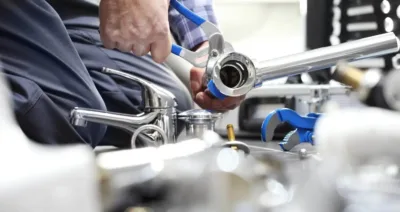While you probably enjoy hard-boiled eggs, hard candy, and hard taco shells, you’re probably not too fond of hard water. And who can blame you? Hard water can leave your faucet looking dingy and have negative effects on your body.
Like most people who have an aversion to hard water, you may have equipped your home with a water softener system to eliminate hard water and keep mineral deposits from forming around your faucets.
While a water softener system will certainly make your home’s water less harsh when used correctly, this handy piece of equipment won’t work unless you keep its brine tank filled with salt.
Before you reach for the saltshaker, you should know that your water softener system may require a special kind of salt. The best water softener systems use potassium chloride; however, plenty of good, reliable water softener systems use sodium chloride or common table salt.
The Negative Effects of Hard Water
The primary purpose of a water softener system is to eliminate or reduce water hardness. Numerous studies have linked hard water (water with excessive amounts of certain minerals) with health problems like:
● Alzheimer’s disease
● Cancer
● Cardiovascular disease
● Diabetes
● Reproductive health issues
The good news is you can protect yourself from the risks of hard water simply by keeping your water softener system’s brine tank filled with salt. Doing so will also improve its performance and energy efficiency and make your utility bills manageable (cha-ching!).
How Often Should You Add Water Softener Salt?
As a rule, you should check your softener’s salt levels at least once a month. Keep one or two bags of water softener salt on hand to refill your brine tank as soon as it starts getting low. Although your neighbors may think you’re trying to ward off evil spirits with your bulk supply of salt, you’ll have the last laugh when your water softener continues to function properly.
Be careful not to overfill your tank, as this could lead to clogs or other issues. If this has already been an issue in the past, we apologize for rubbing salt in a wound (pun intended).
If your water is extremely hard or your softener isn’t working well, your system might be consuming salt at a faster rate. If you notice your brine tank is always empty when you do your monthly check, try switching to a three-week interval.
Choosing the Right Water Softener Salt
Choosing the right water softener salt is easy. Simply follow the instructions provided by the company that installed it.
Research your system’s make and model if you purchased a home with a water softener system. You can also contact a company that provides water softener system service and see if they can point you in the right direction.
If you add the wrong water softener salt to your system, you could damage it and incur significant repair expenses, making it a DIY project you likely want to avoid.
Other Tips for Maintaining Your Water Softener
While the best water softener systems can function reliably for years, even top options will eventually require repairs. Fortunately, you can extend the service life of your water softener system by:
● Monitoring your water quality
● Routinely checking your control panel
● Keeping the salt brine tank filled
If your water softener system starts acting up, contact a professional immediately from a reputable company. An experienced installer can troubleshoot your system, identify the root cause of your issues, and make the necessary repairs to get it running again to avoid adding in-salt to the injury (we had to throw in one last dad joke). Follow their expertise and avoid taking it with a grain of salt if you want to get more use of your water softener.
Now that you understand why adding salt to your water softener system is important, take a look at your brine tank and ensure its topped off. By doing so, you can keep your water free from excess minerals and extend the life of your system.


